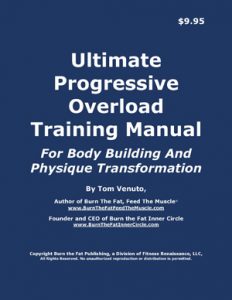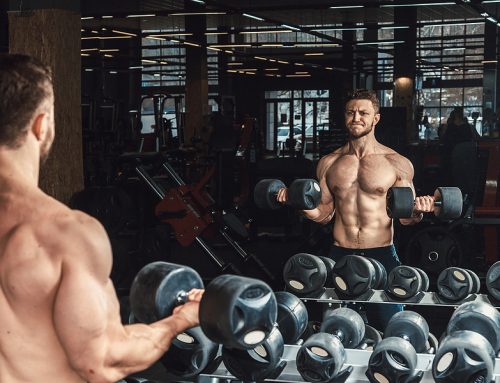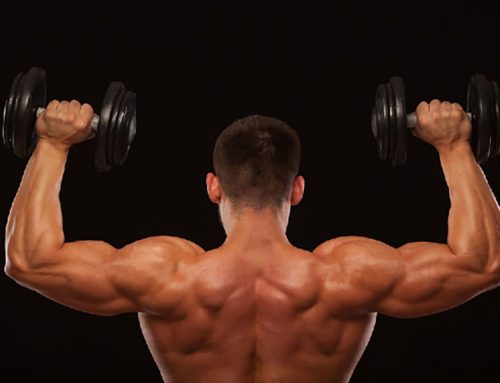How hard must you train to gain muscle? Is pushing yourself all the way to failure – when you can’t do another rep – a critical part making muscle gains? How high does your intensity of effort have to be when you train? If you’re not gaining muscle, is it because you’re not training hard enough? If it’s not intensity, what is the real trigger for muscle growth?

You’d think these are basic questions that would be easy to answer, and yet most lifters and bodybuilders still aren’t quite sure.
It’s no wonder people are confused, because this subject has been mired in debate for decades, and there’s no shortage of people with strong opinions in one direction or the other.
I’d like to not only tackle these questions once and for all – with a combination of science and experience – but also propose a brand new way to look at training intensity, including the question of training to failure…
But first, I want to take you on a short trip back in time, because learning a little “high intensity bodybuilding history” will set the stage for appreciating this breakthrough all the more.
The Historical Reason Why The Intensity Question Is Such A Controversial Topic
When I started lifting in the 1980’s, the name Arthur Jones was known by everyone in the industry, because he was the inventor of Nautilus weight lifting equipment. Long before Planet Fitness, AnyTime fitness, 24-Hour Fitness and the other huge gym chains of today were born, we had Nautilus fitness centers in almost every town.
Everyone who lifted had used or at least seen those ubiquitous old-style, blue-framed, black-upholstered contraptions with the bicycle chain attached to the weight stack (instead of a cable).
But Jones was known as more than an equipment builder and entrepreneur, he also had a unique training philosophy to go along with his invention. He was a fervent believer that the key to building muscle is training so hard that you reach the point of momentary muscular failure, where you can’t perform another rep in good form.
Jones theorized that there was something about reaching the failure point (of complete exhaustion) that acted as the trigger to muscle growth. Anything short of that was considered sub-optimal or even ineffective, as if a set stopped too short meant the whole thing was a waste of time.
Referring to the level of effort, he called this philosophy, “high intensity training.”
The Era Of High Intensity Training (HIT) Gurus
Beginning in the 1970s and picking up steam through the bodybuilding boom of the 1980’s, other fitness experts, trainers and athletes jumped on this wagon and declared themselves coaches or practitioners of high intensity bodybuilding training.
Some did it under the Jones – Nautilus brand, while others improvised their own systems and planted their own flags. Either way, most of them called it HIT for short (not to be confused with HIIT, the acronym for high intensity interval training cardio).
One of those independent personalities was Mr. Universe Mike Menzter, who created the “Heavy Duty” training system after being influenced by the theories of Jones. Others followed, and before you knew it, thanks to celebrity pro bodybuilder endorsement, one of the hottest trends in the muscle building field was high intensity training.
Aside from the claims that HIT was a superior method of training, another appeal was made based on efficiency. Because the intensity was so high, proponents explained, you didn’t have to do a lot of it.
In some cases, you were only required to do one all-out set to failure per exercise. The number of sets and exercises varied based on the coach, but in every case, it was a very low volume of training. “Hard and brief” was the hallmark of HIT.
The promise was not just more muscle, but more muscle in less time. That’s always an attractive and marketable sales pitch.
HIT was promoted as quick, but unlike most other fitness trends, it was never promoted as easy. In fact, an almost machismo work ethic culture of pain and suffering emerged. This didn’t diminish the appeal, it added a challenge and another level of mystique.
High Intensity, “One Set To Failure” Training Under Fire
On the other hand, HIT has always had critics, even back in the early days. After all, bold claims were being made, and when big claims are made, and when an exercise system becomes a business with big money at stake, then eventually, big proof is expected.
There appeared to be anecdotal evidence for HIT. Many trainers who promoted the HIT method were built to the hilt and looked like walking testimonies for their own training philosophy.
But the majority of winning bodybuilders did not use HIT. They may have trained to failure sometimes, and most would describe their workouts as “intense” (no one wants to be considered a sissy), but their programs certainly weren’t one maximum set to failure and done. Far more people used and succeeded with conventional (higher volume) training than HIT.
So the debates continued about which method was better – for years. The issue never seemed resolved.
As decades passed, athletes and experts in the fitness community started getting savvier about demanding evidence to back up claims, and detractors started saying, “Are we supposed to take a guru’s claims at face value? Do you know what ignoring research and only listening to the guy with the most jacked physique is called? Bro-science!” For the first time, people wanted to know what real science said.
There wasn’t much data in the early days. Fortunately, in the 1990’s, the field of strength and conditioning research started to blossom. By the 2000’s, the scientific research – including investigations into what makes muscles grow – exploded, and hasn’t stopped since.
Many of these new studies were done to discover more about how many sets it takes to build muscle at the ideal rate, because that’s part of the same debate; One set to failure? Multiple sets to failure? Multiple sets not to failure? Multiple sets, some to failure, some not?
Other studies were being done to determine whether training to failure stimulated more strength or muscle growth in the first place, or if the pathways and mechanisms of muscle growth involved something completely different.
The results of all this new research have been surprising: Most studies said that multiple sets were better than one set and that training to failure was not mandatory to trigger muscle growth.
When it came to strength and power training, many studies suggested that training to failure was actually inferior. That seemed to match what powerlifters were doing: they train brutally hard and may miss lifts, but almost never train for failure intentionally.
Modern Breakthroughs In the Science Of Training Volume
I’d like to point out (before the HIT squad comes after me), that I’m not saying, nor does the research imply, that HIT training does not work at all. To the contrary, there’s no question that you can build muscle and strength doing a single set and taking that set to failure.
What I’m suggesting, and what science today backs up, is that a single set is not ideal for maximum muscle growth. Even more growth would occur if additional sets were added. Three sets for example, has been proven superior to one (in a recent meta-analysis of all studies). This is a huge area of research interest today.
Recent work has also suggested that you need at least 10 sets per week per muscle group for optimal hypertrophy, and more might be even better for advanced bodybuilders. Furthermore, volume should be periodized, so high volume training all the time may not be ideal either. Here’s what we do know: If you want to do low volume, high intensity at times, have at it, but unless you do more at other times, you’re leaving results on the table.
For years, advocates of HIT preached that most people are overtraining, doing too many sets, and warned us to avoid the more is better mentality. They said less is better if the intensity is higher. Today nearly every researcher and coach agrees that volume is a major driver of muscle hypertrophy and there’s a direct correlation between the two. More is only better to a point, but more is better than one set.
Low volume, high intensity training is not the best way to build the most muscle. It is however, a time-efficient way to build some muscle. There are plenty of people, many because they are busy, who are interested in finding what has often been called, the “minimal effective dose.” That’s the least you can get away with doing and still get results you find acceptable. By definition, however, this comes with acceptance of achieving less than your best…
Minimalist Exercise Is Not The Way To Maximum Results
The lowest number of sets you can do per exercise is one, and that’s enough to stimulate some growth. If you’re only going to do one set, then it makes some sense to milk that set for all its worth and do it with intensity.
But anyone who is competitive or anyone interested in maximizing their genetic potential is not interested in the minimum to squeak by – they want all the results they can get, and that’s the question we are seeking to answer – what is optimal?
The optimal volume is still unknown and it might stay that way because what’s optimal can vary based on each person’s experience level, genetics and recovery ability. We’ll talk about volume in detail in a future post, but thanks to science (combined with keenly paying attention to results), we know the one set debate is over.
But what about the intensity part – training to failure? Has that been settled? Couldn’t one set, if it were taken to absolute failure, produce more growth than three sets that don’t go to failure?
It’s very likely that failure may play a role in increasing muscle growth beyond never using it at all, but it probably occurs due to other conditions being achieved or triggered – it doesn’t look like reaching failure is the critical factor for muscle growth.
Because it’s not mandatory to train to failure, does that mean you should never do it? No – there’s a solid theoretical argument for how failure training could stimulate additional muscle growth. I do believe physique athletes should use it.
Training to failure and using other high intensity training techniques can be a valuable tool, if you do it at the right time, in just the right amount.
High Intensity Is Still A Major Consideration In Your Workouts!
Whether you train all the way to failure or not, make no mistake, working high enough on the intensity of effort scale is absolutely vital – and make note – it is a scale.
In nutrition research, there are some lines of study that suggest thresholds exist for protein to produce it’s positive benefits. If you hit a minimum protein threshold at one point in time, you flip on muscle protein synthesis; if you fall short, you get zip.
But training intensity is different – it’s a relative thing. Intensity is a scale, not a switch – and there doesn’t appear to be a huge difference between leaving a rep or two in the tank and going to failure. (Plus the beneficial effects of submaximal training accumulate after repeated efforts).
Doing a set that you’d rate an 8 or 9 on the perceived exertion scale is a tough workout! To discount that effort because it wasn’t a 10 is ridiculous. Failure is not a switch that suddenly turns growth on and everything shy of failure is still off.
Training for muscle growth doesn’t work that way.
Assuming you have good program design to begin with (plus the right supporting conditions), if there’s any “magic growth switch” it’s the progressive overload you create from one workout to the next (more on that in a minute).
But first, what is that “good program design” I mentioned? What is the resistance training exercise prescription that builds muscle? What are the supporting growth factors? What are the growth mechanisms?
At this point we have enough understanding of what causes muscle growth so that most athletes, coaches, scientists and educational organizations can agree on the essential principles governing what makes muscles grow.
The Right Exercise Prescription For Muscle Growth:
Let’s review these scientific principles of muscle growth, because if we don’t talk about this first, or if your training doesn’t even have specificity to hypertrophy, or if the programming is just plain wonky, then talking any more about failure and intensity is moot.
1. Correct frequency. If you train once every 2 weeks, don’t expect to do much growing (don’t laugh, there are plenty of eccentric trainers and quick-fix snake-oil salesmen still out there today who will tell you that training with extreme infrequency is the key to growth).
2. Correct volume. Volume is an important driver of muscle growth. Flying directly in the face of old-school HIT ideas, more sets are are better, at least as you advance and adapt, and at least up to a point, where you start overreaching.
3. Correct weight. Yes, you need to lift relatively heavy. Loads in the 70-85% or 1RM range are ideal for building muscle and even heavier loads are important for building maximum strength. Yes, recent research says you can build muscle with very light loads (especially if taken to fatigue, incidentally), but if you only train light, your results will fall short of optimal. For hypertrophy, training most of the time in a 6 to 12 rep max range with some very heavy training (1-5 RM) and some light (15-20 and beyond) training is probably ideal.
4. Correct effort intensity level. Don’t choose a weight you can do for 12 reps and stop at 6 reps, that is, literally, a half-assed effort. If you stop so far short of failure that there isn’t even the slightest hint of fatigue or metabolic stress, not much is going to happen. Intensity is absolutely an influence on muscle growth. “High intensity” is important but is ill-defined if you only count a 10 out of 10 exertion level as high. An 8 or 9 exertion level is certainly high intensity training. A 5 out of 10 is not.
This is getting good, so let’s keep going. What else is necessary for muscle growth? There are supporting conditions which must be in place, running in the background at all times, and two of them top the list…
The Right Supporting Conditions For Muscle Growth:
1. Nutrition. Eating less than your BMR in calories? Eating half your food from McDonalds and the other half from Krispy Kreme? Protein intake keeps falling short? Good luck gaining muscle, no matter how hard you train.
2. Recovery. Sleep-deprived? Stressed? Never relax? Mind in turmoil? Going way overboard on frequency and volume? Good luck gaining muscle, even if your intensity is a 10. In fact when under-recovered and stressed, high intensity training makes things worse.
Continuing our discussion about what causes muscle growth (if it’s not “just failure”), next, we have the three underlying mechanisms of muscle growth:
The Mechanisms Of Muscle Growth:
1. Mechanical tension. Your muscles are sensitive to the amount of load placed on them as well as the per set and accumulated volume of the tension produced. When that tension is high enough, that indicates an intensity of effort that can recruit more muscle fibers and trigger growth.
2. Metabolic stress. Lactic acid and other fatigue by-products build up in the muscles, especially after doing a set in the moderate or high rep ranges, indicating a high intensity of effort, even when the weight isn’t that heavy.
3. Muscle damage. No, not the damage of an injury, but the microscopic muscle fiber tears indicative of an intense enough workout. This damage is repaired over time with proper nutrition and recovery and literally rebuilt bigger and stronger than before.
And finally, there is the one major overriding principle that, assuming your program meets all the best practices and conditions above, assures the muscle gains keep coming: progressive overload
The 1 Overriding Principle Of Continuous Muscle Growth:
#1 Progressive Overload. To make continuous gains, you must do more over time; more weight, more volume, more intensity, more frequency, or more quality. Progressive overload is the true key to continuous muscle growth. It is not simply a tactic, it is a long term strategy and guiding principle.
The NEW scientific approach to high intensity training
That brings us to the point where we can pull together these pieces to form a complete picture and come full circle back to the questions about failure training, how hard you should train and how to use high intensity training the intelligent way to increase your muscle gains.
Some people may have started reading this thinking I was going to argue against ever training to failure intentionally. To the contrary. I endorse training to failure, but using in a measured way. Here’s the difference between the old way and this new system…
Keep in mind that this new way works, only assuming you’re following all the modern best practices for resistance training programming, not something bizarre from the back of an ancient muscle magazine or the minimalist “hacks” of a productivity guru.
The Crux Of The New System Of High Intensity Bodybuilding Training:
You use failure and beyond failure techniques not because they are a trigger for muscle growth or mandatory for muscle growth, but as a method to achieve progressive overload. You think of progressive overload on a properly-designed program as the trigger for muscle growth.
In other words, you use them as a pathway for achieving the conditions and activating the mechanisms necessary for growth.
When and how often should you use high intensity techniques? Well you could do them all the time, but you’ll burnout eventually unless you’re Superman or a genetic mutant. You could do them at random, but random is rarely optimal (though thoughtful auto-regulation is good). You could use them in a cyclical manner as part of a periodization plan, getting more and more intense as a training cycle progresses. That’s also a good idea.
But the ideal way to use high intensity tactics that most people aren’t doing yet is to surpass your previous workout performance. You apply these tactics when they help you do more over time. That is using progressive overload – the king of training principles. And you can use it even when you can’t increase the weight, which is usually the sole focus of most people’s overload goals.
The fact is, there are at least 8 ways you can use progressive overload, and introducing high intensity training techniques is one way to do it.
These high intensity techniques include training to failure, and may also include drop sets, rest pause sets, forced reps and any other tactic that helps you move beyond the last workout in some way. You can even use peak contraction and continuous tension or simply improving form as a “high intensity training tactic” because increased repetition quality is arguably an overload method of its own (and a really good one for older lifters with achy joints).
Let me leave you with a quick example today of using intensity techniques as progressive overload.
An Example of Intensity as Overload
At the top of the list of progressive overload training techniques is simply adding more weight than you used in the previous workout. Everyone knows that. Everyone knows you’re supposed to try to increase the weight every time you can.
But everyone who has trained for years also knows that once the honeymoon of the newbie gains is over, and you start getting closer to your genetic potential, strength gains slow down and more time seems spent on plateaus than on the upward growth curve. What then?
This is the point where you introduce the high intensity tactics, rather than using them all the time. If you were stopping your sets 1 to 3 reps short of failure, this is when you push some of your sets to failure – ideally the last set of every exercise.
The benefits occur on multiple levels: If you do more reps than last time, you have overloaded by increasing your volume.
As an interesting sidebar, research on failure training has often been confounded by volume not being equalized between groups. Does something extra happen when you push all the way to failure that produces additional results or is it simply the fact that you did more reps with the same weight than last time?
Either way, the result is the same: New growth! Why? You did more work than you did before. Maybe it was the more reps or maybe it was the metabolic stress that came from the increased intensity, on its own. Probably it was both, but it was also progressive overload.
Progressive overload is a fascinating subject, and it’s fun, not only because by using it, you can enjoy perpetual progress that you can measure and see, but also because it’s more than a science – it’s an art, a pursuit where you can strive for mastery for the rest of your life.
If you would like to learn everything there is to know about progressive overload systems, so you can make continuous muscle gains for years to come, then you will want to read the ULTIMATE progressive overload training manual for body building and physique transformation.
This e-book has just been updated to a new 2nd edition, the techniques are based on science, the results are real-world proven, and you get your copy here:
CLICK HERE To Get Your Progressive Overload Training Manual in the Burn the Fat Inner Circle Store

Tom Venuto is a lifetime natural (steroid-free) bodybuilder, fitness writer and author of Burn The Fat, Feed The Muscle: Fat Burning Secrets of Bodybuilders and Fitness Models and the national bestseller, The Body Fat Solution, which was an Oprah Magazine and Men’s Fitness Magazine pick. Tom has appeared in The New York Times, Wall Street Journal, Huffington Post, Oprah Magazine, Muscle and Fitness Magazine, Ironman Magazine and Men’s Fitness Magazine, as well as on dozens of radio shows including Sirius Satellite Radio, ESPN-1250 and WCBS. Tom is also the founder and CEO of Burn The Fat Inner Circle – a fitness support community for inspiration and transformation
References:
1. Krieger J, Single vs. multiple sets of resistance exercise for muscle hypertrophy: a meta-analysis. Journal of Strength and Conditioning Research, 24(4), 1150-1159, 2010
2. Schoenfeld B, Dose-response relationship between weekly resistance training volume and increases in muscle mass: A systematic review and meta-analysis. Journal of Sports Science, 35(11), 1073-1082. 2017
3. Dose-response of 1, 3, and 5 sets of resistance exercise on strength, local muscular endurance, and hypertrophy.Radaelli R1, Fleck SJ, et al., Strength Cond Res. 29(5):1349-58. 2015.
4. Schoenfeld B, The mechanisms of muscle hypertrophy and their application to resistance training. J Strength Cond Res. 24(10):2857-72. 2010.
Related Articles:
How To Succeed At Training To Failure (Members-Only)
How Hard Should You Train To Maximize Muscle Growth (Members-Only)
How Many Sets Should You Do To Maximize Muscle Growth (Members-Only)







Hi everyone, hi Tom,
Progressive training definitely works (know it on myself :) Not only with weights but especially with volume. However, it’s not clear ‘where’ do we stop? At which point muscle growth actually becomes unhealthy and unneccessary for the body? You’ll probably say, it depends on your goals… Well, my goals are achieved 85% (still have work to do but already look like an athlete after years of training just keeping a little layer of subcutanious fat in certain places that i believe not healthy for women to get rid of)
But I am here not to talk about myself – I keep seeing some really BIIIG people in the gym and at bodybuilding’s competitions. They look like dinosaurs. Slightly grotesque… as if they were one of Nature’s first models of living organisms made just to see if they fit into environment, and then maybe do the ‘tweaking’ later. But wait – Nature didnt’ do it to them, they did it to themselves (steroids users excluding). Which means – they DON’T really need all this mass. Instead of ‘smart’ and ‘elegant’ bodybuilding of Vince Gironda and 1950’s era we now see more and more monsters. Progressive overload gone awry? Look at the guys on your post’s picture. One on the right… (one on the left is ok). Hmm… I seriously crave to eat his arm for dinner…(wouldn’t take the whole arm, only what he doesn’t need :)) That’s not a bad enough example though… You see real monsters at competitions – overstrained muscles, tissues seem like they are ready to pop up open as if screaming, ‘plz, stop! Can’t take it anymore!’…
Ok, I am not against bodybuilding, I am for it. And don’t get me wrong – I admire your method and what you’ve done for yourself and many other people. My point (from the perspective of a former doctor, actually) – there should be a point of growth after which it becomes unhealthy for the body to get bigger. Everything in the body should correspond to the function performed (normal function not forced by constant overstrain). Everything that is ‘unnecessary’ will take additional energy to sustain and will also take energy AWAY from your other, more important, life sustaining processes.
Then, there’s of course, your heart muscle. Much more mass means much more pumping by the heart muscle which means miocardial hypertrophy and much higher risk of cardiomyopathy. And many bodybuilders have died from it !! Plus, induced (purposefully) mechanical strain and metabolic stress.. We now know (and there’re many publications in cardiological journals on that) that metabolic stress easily contributes to enlargement of heart atria, their fibrosis (scarring) and this is directly connected to cardiomyopathy, A Fib (atrial fibrillation) which is linked to increased morbidity and mortality. I don’t think ‘get 8 hours of sleep’ is going to cut it here…
So, Tom, the question is where do we stop? :) I think it’s important to determine. Make a cycle of overloading, then de-load, then start overloading again? Pro athletes got to stop at a certain point… Maybe they got to do a periodical Echocardiogram as a control (seriously… once a 6 months?) But it’s even more important for the general public who haven’t been exactly exercising regularly all their lives, (and whose heart got used to pump a certain volume per unit of time) up to the point when they suddenly got inspired by the whole BB idea including progressive overload, in their 30’s or 40’s or even 50’s…?
Hi Irinia. I think you somewhat answered your own question. First off, bodybuilder physiques that look ‘grotesque’ or overdone are almost always the result of steroids, growth hormones and other anabolic and performance enhancing drugs, not bodybuilding, training or progressive overload taken too far. I endorse and practice natural bodybuilding and you really cannot over do it when you do it naturally – drug free muscle growth is very difficult and it happens very slowly. The closer you get to your genetic potential, the slower the gains come so you can only pursue tiny progressions anyway as you advance – there are no more big jumps, and after a certain age, physical declines begin and so priorities often shift to health, fitness and function not maximum muscle mass and strength. However, progression never stops. Goals may change, priorities may shift, but bodybuilding and fitness is a lifestyle and a “path” for personal development – a lifelong journal journey where we are always be working on progressively realizing a worthy goal of our choosing. And thats the ticket – we choose our own fitness goals.
Tom,
of course I know you practice natural bodybuilding. I understand that ‘drug free muscle growth is very difficult and happens very slowly’ (mostly for ectomorphs and mesomorphs) but endomorphs can still grow pretty big… and although I was talking abt ‘steroid excluding’ cases, you’re right – ‘overdone’ physics are most probably drug inhanced…
What i meant was there should be some ‘point’ where to stop overloading. Are you saying we should NEVER stop overloading? Obviously, personal growth is a life term goal … But priorities HAVE to BE on health and function to begin with, not just ‘shift’ with age. They should never shift from health. I think after achiving certain physical results we’ll just have to maintain.
Because in order to induce the growth you have to force the strain on muscles and the body in general, therefore induce ‘stress’. And even, as you said, if ‘you pursue tiny progressions as you advance’’ – you still subject body to stress. Now, every time metabolic stress kicks in – sympathetic nervous system responsible for «fight-or-flight» responce, kicks in – kidneys produse Renin, which, thru the chain of other reactions, produces Angiotensin II. Angiotensin II ups the arterial pressure and it’s an adaptive mechanism (for taking action under stress) but doing this repeatedly now also linked to cardiac muscle remodelling (hypertrophy, scarring and apoptosis of cells). Scarring and atrial hypertrophy of heart atria are factors to developing A Fib (atrial fibrillation) and other comorbidities which are linked to adverse outcomes.
We dont’ get infinite amount of Energy per lifetime. There’s a known relationship between Energy and Time in physics – them being always inversely proportional. If you UP the intensity (energy) your Time will always go DOWN (shorten). It’s an underlying principle of the Universe. You can’t skip it or try to operate around it. The more energy you spend on feeding, on pushing hard and ‘overloading’ during your workouts, or even processing food – ‘the faster the candle burns’ and the shorter its life span. We are subject to laws of thermodynamics and gradually wear out just like everything else in the Universe, and the amount of energy we can use goes down. So, you can’t ‘overload’ forever.
Anyway, I haven’t figured out this one yet either… and although I myself keep training mostly intensely, I begin to question if it’s really that necessary. I seriously think everyone who ‘’progressively overloads’’ over years or already have big physique should start doing controlling Echocardiogram every year or two after 30-35 when using ‘progressive overload’. ( Have you done yours yet ? :) And from my experience, cardiologists or especially general practitioners don’t know the science of bodybuilding well enough to recommend this. All research on ‘’athletic heart’’ just starting to take off
It’s a nice summary of HIT, but there’s not one study cited to support his conclusion that higher volume equals more muscle.
Several references are at the bottom of the page. Higher volume = more muscle (inside recovery capacity) is virtually common knowledge at this point.